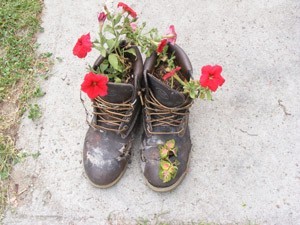 Generations ago, our grandparents threw away nothing. Only the very worn and useless items found their ways into the trash. They repurposed everything. Yet, today our things have become disposable. We replace and purchase too often, cluttering our garages and emptying our wallets. When it comes to plant care, our wallets donate a great deal to the maintenance and decor of plants. Instead, do some creative repurposing and recycle while you save.
Generations ago, our grandparents threw away nothing. Only the very worn and useless items found their ways into the trash. They repurposed everything. Yet, today our things have become disposable. We replace and purchase too often, cluttering our garages and emptying our wallets. When it comes to plant care, our wallets donate a great deal to the maintenance and decor of plants. Instead, do some creative repurposing and recycle while you save.
For plant protection, try scouring flea markets for used bird and critter cages. Don't go to the pet store and pay for new ones. The cages can be bent or even broken; you'll probably take them apart anyway. Spray paint your cages a flat black, a bright white, or even a metallic silver to make them attractive for your patio decor, and then place your houseplants inside. This is a great way to make a window sill sitter into a hanging plant for the summer. It also protects them from bothersome critters.
If your garden plants are under attack, try taking the bottom off of a large guinea pig, hamster, or rabbit cage to leave only the wire top. Then, place it over the top of the plants when they are still young. It saves the effort of fencing in the entire garden for one plant or a set of seedlings. Rabbits eat all of my tender young shoots, so protection during the sprouting phase is all I need.
This page contains the following solutions.
If you have plants or trees that you don't want, recycle by calling your City Hall and asking if their Parks and Rec. dept can pick them up for replanting. I do and it saves the city money and adds beauty to the parks.
Here are the questions asked by community members. Read on to see the answers provided by the ThriftyFun community.
Does anyone have any tips for green gardening? Thank you.
Hardiness Zone: 9b
By Linda Cheatham from Whittier, CA
the best tip are to find plants that are appropriate for your zone, whether vegetables or flowers, so that you have to rely less on artificial watering, pesticides, and fertilizers.
THis is a good site that determines the hardiness of plants. "The 2012 USDA Plant Hardiness Zone Map is the standard by which gardeners and growers can determine which plants are most likely to thrive at a location. The map is based on the average annual minimum winter temperature, divided into 10-degree F zones. " planthardiness.ars.usda.gov/
you can also look at permaculture techniques, which are a way to plan a garden with the seasons and the landscape in mind. permacultureprinciples.com/
If its vegetable gardening, Square Foot Gardening by Mel Bartholemew was an excellent source.
I am looking for green ways to plant my garden, any tips? I already know about paper pots and plantable paper. Thanks.
Hardiness Zone: 9a
By Kimberli from McMinnville, OR
We use newspaper around our plants. Its biodegradable, it helps hold in water and moisture, and it helps keep weeds at bay. We use it around shrubs and in flower beds mostly. Its an easy way to recycle without having to go to the recycling center!